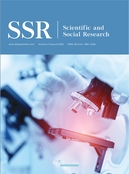Abstract
Sound evaluation of the quality of tourism experience of historical and cultural blocks under the background of urban renewal is of great significance for integrating culture and through tourism. Yongqing Fang Alleyway is an example of micro-transformation in Guangzhou. Therefore, this paper aims to create a system of evaluation of tourism experience using questionnaire surveys and statistical tools. The results indicate that: (1) The evaluation system of tourism experience quality in historical and cultural blocks consists of five dimensions: revival of cultural heritage, environmental atmosphere, tourism projects and activities, tourism services, and overall subjective experience; (2) The comprehensive evaluation of tourism experience quality of Yongqing Fang is favorable, manifested by high evaluation of environmental atmosphere index and architectural historical features, low evaluation of tourism service index, tourism novelty, consumer price, and interactive project participation. Based on the above analysis results, this paper seeks to put forward suggestions to optimize the evaluation of tourism experience quality in Yongqing Fang, which provides a reference for testing and improving the micro- transformation effect of historical and cultural blocks.
References
Cai YN, Yang XJ, Li DL, 2017, “Micro- transformation”: The Renewal Method of Old Urban Community. Urban Development Studies, 24(04): 29–34. http://doi.org/10.3969/j.issn.1006-3862.2017.04.005
Niu Y, Wang DG, 2015, Influence Mechanism and Innovation of Tourism Development Pattern of Historic Streets Based on the Perspective of Tourists: A Case of Pingjiang Road of Suzhou. Geographical Research, 34(01): 181–196.http://doi.org/10.11821/dlyj201501016
Al-haglaks, 2010, Sustainable Urban Development in Historical Areas Using the Tourist Trail Approach: A Case Study of The Cultural Heritage and Urban Development (CHUD) Project in Saida, Lebanon. Cities, 27(4): 234–248. http://doi.org/10.1016/j.cities.2010.02.001
Sun F, From Space Production to Space Experience: A Logical Investigation of the Renewal of Historical and Cultural Blocks. Dong Yue Tribune, 41(07): 149–155.
Qi J, 2017, The Spatial Reconstruction and Renewal of Historical and Cultural Precincts. Journal of Guangxi University for Nationalities (Philosophy and Social Sciences Edition), 39(06): 15–20.
Wu RH, Zhang HL, Zhang J, et al., 2014, Micro-scale Spatial Structure and Spatial Associations of Urban Historical and Cultural Tourism Destinations: A Case Study of Confucius Temple, Nanjing. Geographical Research, 33(12): 2427–2436. http://doi.org/10.3969/j.issn.1009-6000.2009.11.011
Zhang Q, Dong WQ, 2019, The Analysis of Upgrading and Developing Ethnic Historical District from The Perspective of Cultural Industry: Taking Xi'an Hui Min Street as an Example. Guangxi Ethnic Studies, 2019(01): 127–132.
Song H, 2015, On the Development of Cultural Landscape in the Historic District of Minority Nationality: Based on the Perspective of National Tourism. Guizhou Ethnic Studies, 36(12): 157–160.
Luo Y, 2017, Problems and Countermeasures in the Protection of Famous Historical and Cultural Cities. Gansu Social Sciences, 2017(01): 251–255.
Ruan YS, Sun M, 2001, The Study on Some Issues Related to the Conservation and Planning for the Historic Streets and Areas in China. City Planning Review, 2001 (10): 25–32. http://doi.org/10.3321/j.issn:1002-1329.2001.10.005
Liang Q, 2005, Construction of Dual-system Model of Protection of Historical Blocks. Architecture Journal, 2005(12): 36–38. http://doi.org/10.3969/j.issn.0529-1399.2005.12.012
Jiang LQ, Xiong Y, 2015, Influencing Factors of Tourists’ Satisfaction in Historical and Cultural Blocks-Taking Huishan Ancient Town as an Example. Urban Problems, 2015(05): 27–33.
Liu HM, Hu J, Jia YY, et al. Study on Tourism Experience Quality of Historical and Cultural Districts Based on the Perspective of Embodied – A Case of Jianghan Road and Zhongshan Avenue. Journal of Central China Normal University (Natural Science Edition), 55(01): 128–136. http://doi.org/10.19603/j.cnki.1000-1190.2021.01.018
Wu JF, 2014, Concepts Research of Tourism Nucleus, Tourism Resources, Tourism Products and Tourism Experience. Economic Management, 36(08): 126–136.
Ryan C, 1991, Recreational Tourism: A Social Science Perspective. Contemporary Sociology, 22(03): 436. http://doi.org/10.2307/2074558
Su Q, 2004, A Study of Types on Tourists and Their Experience Quality – A Case Study of Zhouzhuang. Geographical Sciences, 2004(04): 506–511. http://doi.org/10.3969/j.issn.1000-0690.2004.04.020
Fornell C, Johnson MD, Anderson EW, et al. 1996, The American Customer Satisfaction Index: Nature, Purpose, and Findings. The Journal of Marketing, 60(4): 7–18. http://doi.org/10.2307/1251898
Sun XL, Lin BS, Gao J, 2018, A Review on the Quality Assessment of Tourism Experience: Advances, Elements, and Prospects. Human Geography, 33(01): 143–151. http://doi.org/10.13959/j.issn.1003-2398.2018.01.019
Ai JL, Deng QF, 2008, Traveling Experience Quality Appraisal Target System and the Assessment Method Grind. Journal of Hunan City University, 2008(01): 51–54. http://doi.org/10.3969/j.issn.1672-1942.2008.01.012
Tang P, He JM, 2020, The Impact of Cultural Heritage Rejuvenation Experience Quality on Visitors’ Destination Loyalty: A Serial Multiple Mediation Model. Nankai Business Review, 23(05): 76–87.
Nunnally JC, 1978, Psychometric Theory. American Educational Research Journal, 5(3): 83. http://doi.org/10.2307/1161962
